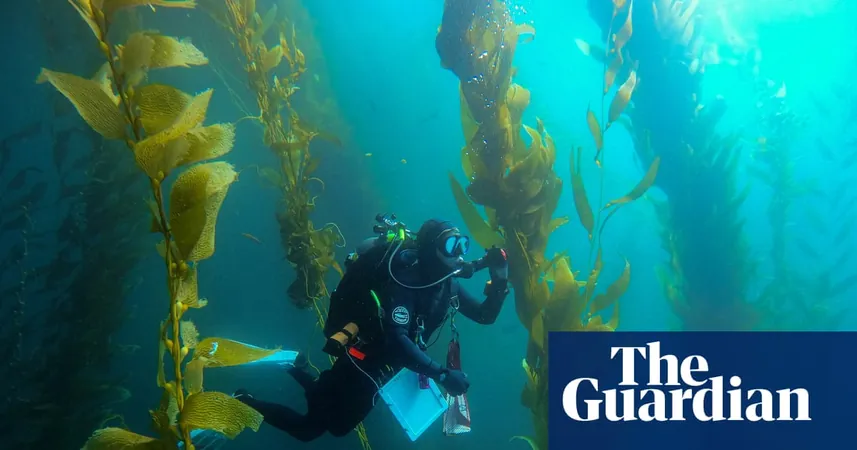
Discover the Surprising Revival of California's Underwater Forests: A Kelp Restoration Miracle
2025-08-31
Author: Daniel
On a cloudy July Tuesday, divers Mitch Johnson and Sean Taylor gear up on the R/V Xenarcha, a 28-foot boat off Rancho Palos Verdes, just south of Los Angeles. Below them lies a mesmerizing underwater forest, filled with thick, army-green kelp swaying gracefully in the Pacific's clear waters.
Once a thriving habitat, the giant Pacific kelp forests have suffered an astonishing 80% decline over the last two decades, largely due to warming seas, pollution, overfishing, and an explosion of hungry sea urchins. These spiky invaders have wreaked havoc, devouring the very kelp essential for the marine ecosystem.
However, hope is not lost. Scientists have launched one of the world's most ambitious kelp restoration projects, enlisting legions of divers to tackle the urchin problem head-on. Today's mission? Evaluate the success of these underwater warriors.
The view from the boat shows how robust the kelp has become; at places, it forms a thick mat at the water's surface, creating a perch for egrets and herons eyeing the fish beneath. This ecosystem teems with life, from vibrant orange garibaldi fish to sleek white sharks and immense blue whales cruising the nearby channel.
Equipped with cameras and measuring tapes, the divers prepare to assess the forest's health. Chief Executive Officer of the Bay Foundation, Tom Ford, checks in as they plunge into the water, leaving Ford and me to await their findings amidst the gentle lap of the waves.
Over the past 13 years, divers in Santa Monica Bay have dedicated nearly 15,600 hours underwater to combat the purple urchin onslaught. The staggering results? Over 5.8 million purple urchins smashed and 80.7 acres (the equivalent of 61 football fields) cleared, paving the way for kelp's regrowth.
The Kelp Forest Revival: A Critical Ecosystem at Stake
Kelp forests, often dubbed the 'sequoias of the sea,' are invaluable. They not only store significant amounts of carbon but also provide habitat for over 800 marine species and buffer storm waves. Being a type of macroalgae, kelp can grow astonishingly fast—up to 2 feet a day—and reach heights of 100 feet.
Experiencing these underwater forests is like entering a surreal fairytale. According to Ford, the first dive into the kelp canopy felt like discovering a shimmering cathedral, with beams of sunlight streaming through the blades and colorful fish darting about like enchanted sprites.
The Unfolding Struggle Against an Ecosystem Imbalance
However, this enchanting scenery has been under threat. Since 2012, the Bay Foundation battled against sprawling carpets of purples created by the urchins, part of a systemic ecological collapse stemming from various factors: the near disappearance of sea otters due to hunting, excessive pollution from DDT, and the recent disappearance of local sea stars, the urchins' natural predators.
Research showed that the ideal density of urchins per square meter was just two, whereas some areas saw numbers soar to 70 or 80. These starved husks of urchins wreaked further havoc, stunting any kelp growth.
With funding from state and federal grants, the Bay Foundation employed divers and volunteers while collaborating with commercial fishers. Ford emphasized that they weren’t targeting healthy urchins vital for local fisheries; rather, they aimed to restore the kelp ecosystem while ensuring sustainable fishing practices.
Restoration Efforts: A Hands-On Approach to Healing Oceans
Terry Herzik, a dedicated sea urchin fisher, joined forces with the Foundation and now works tirelessly to clear urchins instead of harvesting them, putting in countless hours underwater. The labor-intensive process resembles a construction job; divers methodically smash urchins while braving the weight of cumbersome scuba suits.
However, the payoff is immense: kelp can rebound dramatically after a reduction of urchins. Johnson recalls a spot where kelp flourished again within three months, a testament to the tenacity of this underwater species.
A Growing Hope for Underwater Forests
Upon resurfacing, Johnson and Taylor excitedly report their findings: a bountiful kelp forest rich with marine life, although a creeping pocket of urchins remains a concern. As they descend again, kelp abundance is so great it keeps the boat anchored.
I marvel at a kelp frond covered in tiny creatures, evidence of its critical role as a habitat. Each blade indicates promise; kelp is motivated by survival, always striving to flourish against challenges.
The restoration project not only serves as a beacon of hope for kelp in California but could inspire similar efforts globally. While climate change poses future threats, current restorations have shown resilience, with renewed aquatic life and improved water quality—the signs of a revitalizing ecosystem.
Perhaps California's kelp forests are on the cusp of a fairytale revival, ready to restore balance to the marine world and enrich the coast for generations to come.



 Brasil (PT)
Brasil (PT)
 Canada (EN)
Canada (EN)
 Chile (ES)
Chile (ES)
 Česko (CS)
Česko (CS)
 대한민국 (KO)
대한민국 (KO)
 España (ES)
España (ES)
 France (FR)
France (FR)
 Hong Kong (EN)
Hong Kong (EN)
 Italia (IT)
Italia (IT)
 日本 (JA)
日本 (JA)
 Magyarország (HU)
Magyarország (HU)
 Norge (NO)
Norge (NO)
 Polska (PL)
Polska (PL)
 Schweiz (DE)
Schweiz (DE)
 Singapore (EN)
Singapore (EN)
 Sverige (SV)
Sverige (SV)
 Suomi (FI)
Suomi (FI)
 Türkiye (TR)
Türkiye (TR)
 الإمارات العربية المتحدة (AR)
الإمارات العربية المتحدة (AR)